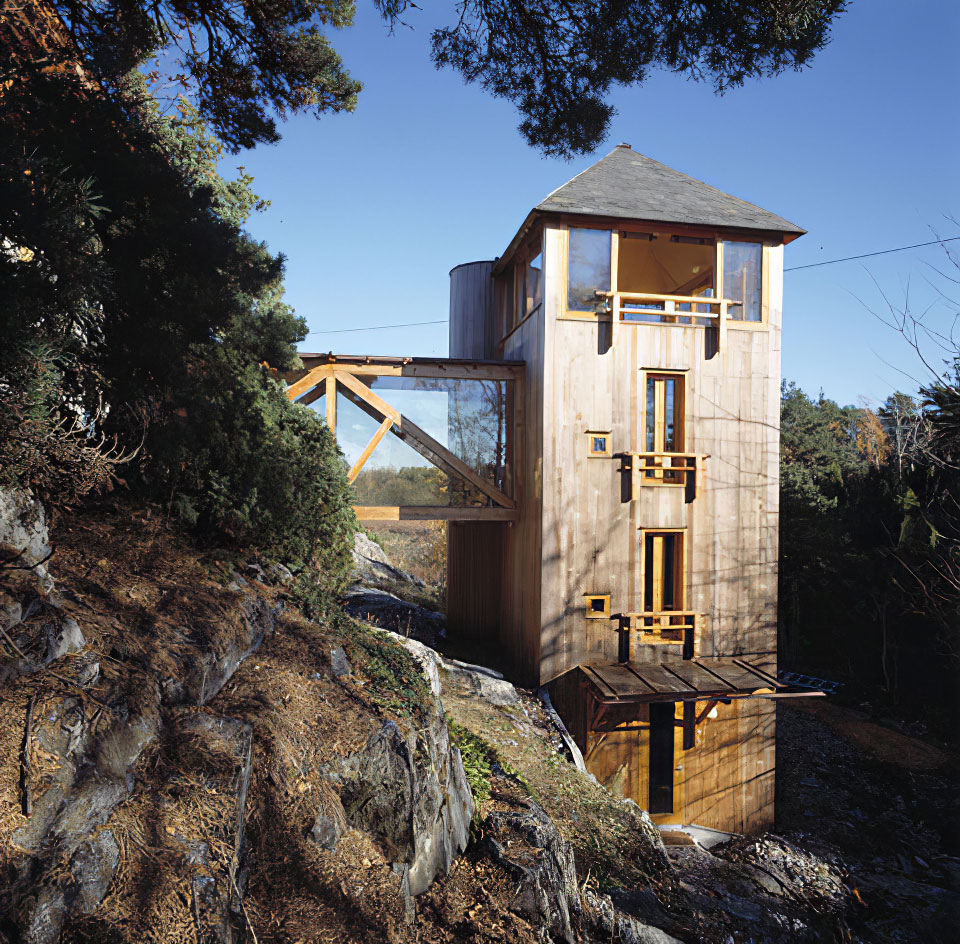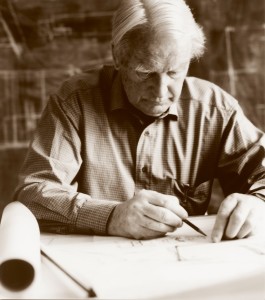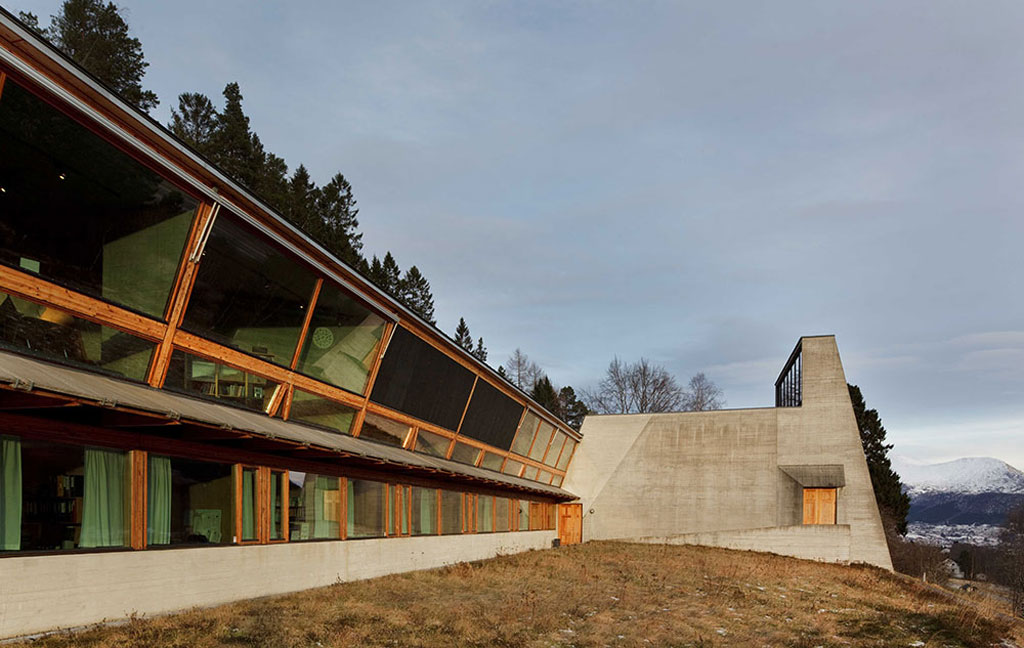ARCHITECTURE: Sverre Fehn
 The Norwegian architect Sverre Fehn (14/8/1924-23/2/2009) is recognized in Europe as one of Norway’s most gifted architects and is categorized by most architectural writers as a modernist. He is known for his designs of private houses and museums that integrated modernism with traditional vernacular architecture. He designed over 100 buildings however by the time he was awarded both the Pritzker Architecture Prize and the Heinrich Tessenow Gold Medal in 1997, only 11 had been built.
The Norwegian architect Sverre Fehn (14/8/1924-23/2/2009) is recognized in Europe as one of Norway’s most gifted architects and is categorized by most architectural writers as a modernist. He is known for his designs of private houses and museums that integrated modernism with traditional vernacular architecture. He designed over 100 buildings however by the time he was awarded both the Pritzker Architecture Prize and the Heinrich Tessenow Gold Medal in 1997, only 11 had been built.
By Efi Michalarou
 Born in Kongsberg, Norway in 14/8/24, he attended the Oslo School of Architecture and received his degree in 1949. Sverre Fehn, along with Norberg-Schulz, Grung, Mjelva & Vesterlid and the Danish architect Jørn Utzon, formed the organization PAGON (Progressive Architects Group Oslo Norway), the Norwegian branch of CIAM (International Congress of Modern Architecture). PAGON had a profound influence, creating architecture which had a firm foundation in the Modern Movement, but was expressed in terms of the materials and language of their own region and time. For his work Sverre Fehn says: “When I build on a site in nature that is totally unspoiled, it is a fight, an attack by our culture on nature, in this confrontation, I strive to make a building that will make people more aware of the beauty of the setting, and when looking at the building in the setting, a hope for a new consciousness to see the beauty there, as well”. While traveling in Morocco in the early 1950’s and studying the local vernacular architecture, he developed a new respect for the realities of construction, as opposed to abstract forms, and for the importance of poetry and instinct in architecture. After Morocco he worked with Prouvé in Paris (1953-54), where he met Le Corbusier. In reminiscing about that period, Fehn recalls that it was his generation that distanced itself from Le Corbusier and his urbanistic world. In 1954 Mr. Fehn returned to Norway and established an architectural practice. He received international attention for his Norwegian Pavilion at the World Exhibition in Brussels in 1958, and again in 1962 for his Nordic Pavilion at the Venice Biennale. Sverre Fehn consider light another material of construction, this is more evident that in the Nordic Pavilion in Venice Biennale. The building consists of concrete bearing walls, with a two-way concrete clear-span roof with openings for tree trunks where necessary. The building is literally built around growing trees. The leafy branches of the trees, and the design of the roof beams to diffuse the light from the sun, provide the interior exhibition space with a soft light that has been characterized as Nordic. Few of his designs were realized, and nearly all his work was done in Scandinavia. When he received the Pritzker Prize he had completed 11 buildings, among them the Storhamar, a converted barn that forms part of the Hedmark Museum (1973) and the Aukrust Museum (1993-96). His best known building is Glacier Museum, which has been hailed as a major landmark in contemporary architecture. The building stands on the plain carved out by the Josstedal Glacier at the mouth of the Fjaerland Fjord. The museum is the center of a panorama formed by the steep mountainsides and the fjord with the glacier on top. In 1971, he became a professor of architecture in Oslo, where he taught until 1993. Fehn has lectured extensively in Europe, in the USA he has been a guest lecturer in many universities including: Massachusetts Institute of Technology, Harvard and Yale universities. His final years were marked by a burst of activity. He designed the Oslo headquarters of the Gyldendal publishing house, which was completed in 2007, and the Norwegian Museum of Architecture, which opened in March 2008 with a retrospective exhibition of his work.
Born in Kongsberg, Norway in 14/8/24, he attended the Oslo School of Architecture and received his degree in 1949. Sverre Fehn, along with Norberg-Schulz, Grung, Mjelva & Vesterlid and the Danish architect Jørn Utzon, formed the organization PAGON (Progressive Architects Group Oslo Norway), the Norwegian branch of CIAM (International Congress of Modern Architecture). PAGON had a profound influence, creating architecture which had a firm foundation in the Modern Movement, but was expressed in terms of the materials and language of their own region and time. For his work Sverre Fehn says: “When I build on a site in nature that is totally unspoiled, it is a fight, an attack by our culture on nature, in this confrontation, I strive to make a building that will make people more aware of the beauty of the setting, and when looking at the building in the setting, a hope for a new consciousness to see the beauty there, as well”. While traveling in Morocco in the early 1950’s and studying the local vernacular architecture, he developed a new respect for the realities of construction, as opposed to abstract forms, and for the importance of poetry and instinct in architecture. After Morocco he worked with Prouvé in Paris (1953-54), where he met Le Corbusier. In reminiscing about that period, Fehn recalls that it was his generation that distanced itself from Le Corbusier and his urbanistic world. In 1954 Mr. Fehn returned to Norway and established an architectural practice. He received international attention for his Norwegian Pavilion at the World Exhibition in Brussels in 1958, and again in 1962 for his Nordic Pavilion at the Venice Biennale. Sverre Fehn consider light another material of construction, this is more evident that in the Nordic Pavilion in Venice Biennale. The building consists of concrete bearing walls, with a two-way concrete clear-span roof with openings for tree trunks where necessary. The building is literally built around growing trees. The leafy branches of the trees, and the design of the roof beams to diffuse the light from the sun, provide the interior exhibition space with a soft light that has been characterized as Nordic. Few of his designs were realized, and nearly all his work was done in Scandinavia. When he received the Pritzker Prize he had completed 11 buildings, among them the Storhamar, a converted barn that forms part of the Hedmark Museum (1973) and the Aukrust Museum (1993-96). His best known building is Glacier Museum, which has been hailed as a major landmark in contemporary architecture. The building stands on the plain carved out by the Josstedal Glacier at the mouth of the Fjaerland Fjord. The museum is the center of a panorama formed by the steep mountainsides and the fjord with the glacier on top. In 1971, he became a professor of architecture in Oslo, where he taught until 1993. Fehn has lectured extensively in Europe, in the USA he has been a guest lecturer in many universities including: Massachusetts Institute of Technology, Harvard and Yale universities. His final years were marked by a burst of activity. He designed the Oslo headquarters of the Gyldendal publishing house, which was completed in 2007, and the Norwegian Museum of Architecture, which opened in March 2008 with a retrospective exhibition of his work.













